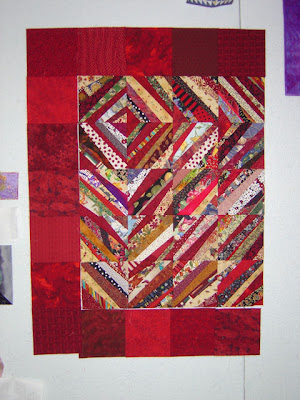Necessity is definitely the mother of invention.
Today I invented a $3 stitch regulator which will keep my sewing machine control pedal from sewing at the highest speed. I have a high speed machine and it's hard to keep the speed just where I need it when I'm machine quilting. If you have the same problem while machine quilting and using a sewing machine with a foot controller pedal, this solution may work for you too. Here's how I made it:
***Please follow all safety precautions and use common sense if your foot pedal is different than mine.Supply List:
- Heavy duty felt pad, as large as you need (available at home improvement stores or Walmart for about $3.00). They are usually used under furniture to protect floors.
- rotary cutter with an old blade or a blade used for paper, not your good fabric blades
- square ruler
- cutting mat

I had these self-sticking felt pads on hand, and in the photo below you'll see the 1/4" piece of felt that I tried first on my foot controller pedal...

I used my ruler and rotary blade to straighten one of the edges of the felt.

Then I turned it around and measured 3/8" and cut a long rectangular piece from the felt.

The photo below is my foot controller pedal...

Here it is with the self-stick felt pad on it, positioned in just the right place to keep my pedal from sewing out-of-control fast. This level on my pedal is just right for an even stitch with a somewhat swift movement of the fabric...therefore, I can put full pressure on the pedal and keep it at a
perfect constant speed!


The heavy duty felt will give a little, so you may need to cut several slices in 1/8" increments from the felt before you find the size that works best for you.
What do you think? If you try this, let me know how it works for you, and send along any tips you find that help it to work better.
The "necessity" for this stitch regulator was simple...I have short legs, but the chair must be high enough to see my work and move the quilt sandwich easily, while at the same time my foot must reach the
pedal comfortably. I often have to adjust myself as I machine quilt, which puts too much pressure on the pedal and runs the stitching out of control for a few inches of teeny tiny stitches. This "regulator" will keep that from happening while allowing me to put full and constant pressure.
 Thank you, Mary Stori, for encouraging me to change my teaching format to digital. So far all of my quilt guild program presentations have been made using a flip chart. If you're too young to know what that is, don't tell me please.
Thank you, Mary Stori, for encouraging me to change my teaching format to digital. So far all of my quilt guild program presentations have been made using a flip chart. If you're too young to know what that is, don't tell me please.






































